Report
1. Healthcare private equity market 2012: The year in review
Section highlights
• Global healthcare private equity deal value declines for the first time in three years in 2012, though the volume of deals is stable
• The mega-deals that defined 2011 give way to a spate of smaller middle-market transactions
• The largest investment funds struggle to put meaningful amounts of capital to work efficiently
• Heightened competition for smaller deals is boosting prices all around
Private equity investors in the healthcare industry saw some dramatic shifts in 2012. While the number of healthcare deals held steady, the mega-deals that defined the previous year all but disappeared, giving way to much smaller middle market transactions. As a result, global deal value for the sector saw its first decline in three years, decreasing 30% to $21 billion in 2012 (see Figure 1). The number of deals remained approximately the same, however, and despite the smaller investment sizes, healthcare captured a meaningful share of total global private equity investment in 2012. Based on deal value, healthcare accounted for just over 10% of all private equity investments made during the year, well above the sub-10% levels seen for most of the past decade.
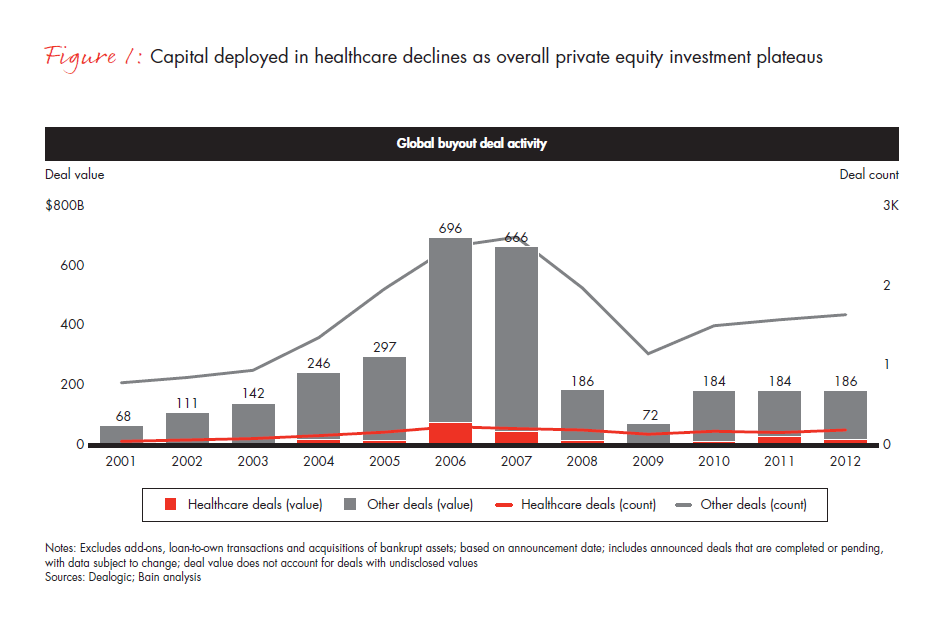
One illustration of how the scale has changed from year to year: The largest deal in 2012, TPG’s purchase of Par Pharmaceutical for $2.2 billion1, was a mere one-third the size of 2011’s biggest deal, the acquisition of KCI by Apax Partners for $6.3 billion2. All told, the 10 largest healthcare private equity acquisitions in 2012 tallied $12.6 billion, half of the $25 billion seen in 2011 (see Figure 2). Replacing this mega-deal activity was a spate of middle market deals that boosted median deal size to $45 million, more than twice the $20 million recorded in 2011. Although this shift in deal size meant the largest firms had less of a chance to make a splash, it opened up many opportunities for a broad spectrum of smaller firms.
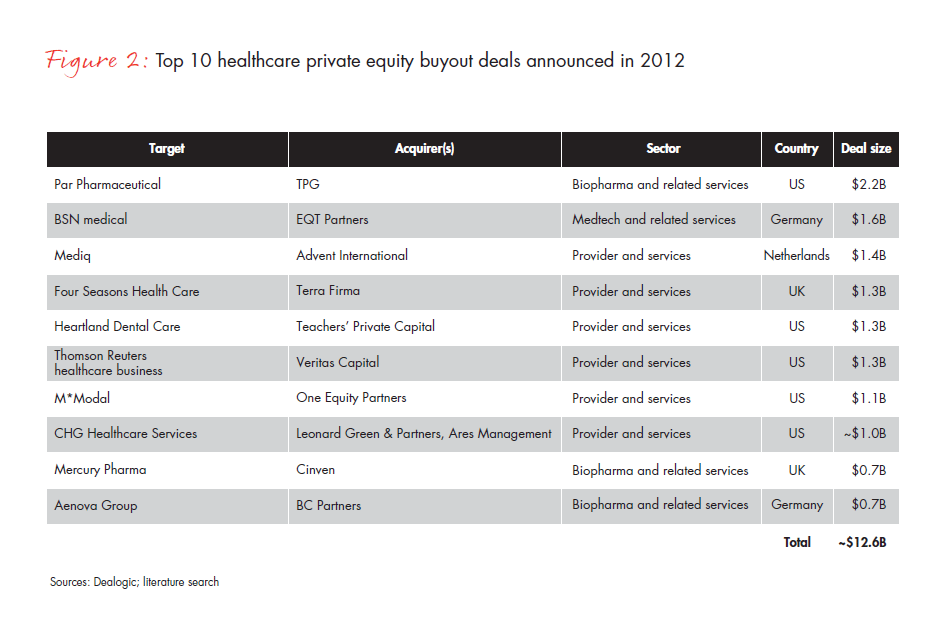
These deals spanned the full range of healthcare sectors, including medical technology, pharmaceuticals and healthcare providers and services. Geographically, the largest deals were concentrated in the US and Europe, with no deals in Asia-Pacific topping $600 million.
2. Geographic trends
Global
Section highlights
- North America and Europe continue to be hotbeds for healthcare private equity activity, but there is growing interest in Asia-Pacific
- Asian markets are intriguing but not easy to enter
- All regions are facing growing competition for assets, macro pressures toward cost containment and slowing innovation within the pharma and medtech pipelines
By the numbers, North America and Europe continue to be the main arenas for private equity investments in healthcare. Deal activity was relatively flat in both of those geographies over the past year.
One clear theme that emerged in 2012, however, was the growing level of private equity firms’ interest in healthcare in China, India and across the Asia-Pacific region (see Figure 3). With opportunities abounding and restrictions on foreign direct investment relaxing to some extent, Western funds are building up their presence in Asia-Pacific by opening new offices, especially in China and Southeast Asia. Over the next several years, deal activity is likely to continue heating up in new geographies as it stabilizes in traditional ones.
Despite the allure of new markets, Western investors face a healthy dose of competition from local investment firms that have already taken root in the regions and strategic players searching for new outlets for growth. At the same time, investors based in the Arabian Gulf region (including sovereign wealth funds) are also investing heavily in emerging markets, with the long-term goal of bringing much-needed healthcare solutions back to their home countries. Given their unconventional investment theme, such investors are often willing to accept lower returns, consequently bidding up valuations across the board.
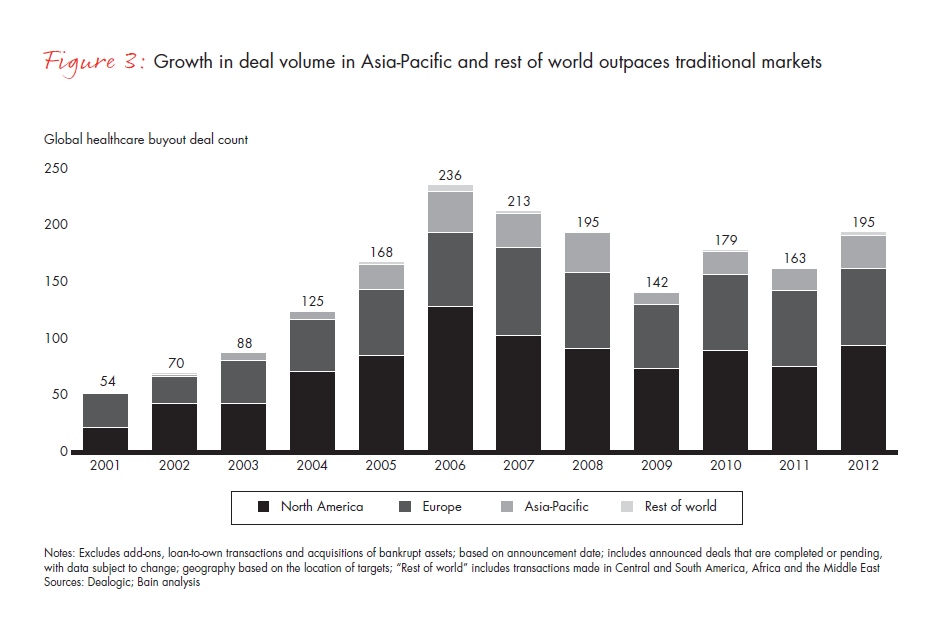
Interest in the key healthcare sectors varied meaningfully by region. In North America (primarily the US), provider and services firms dominated investment activity; within Europe and Asia-Pacific, activity was more evenly distributed (see Figure 4). Within Asia-Pacific, there was wide variation by country as well, with most investments in China focused on biopharma, while most in India focused on providers and services. One theme that cut across sectors and geographies is cost containment, and all regions are facing the pressure of slowing innovation within the pharma and medtech pipelines.
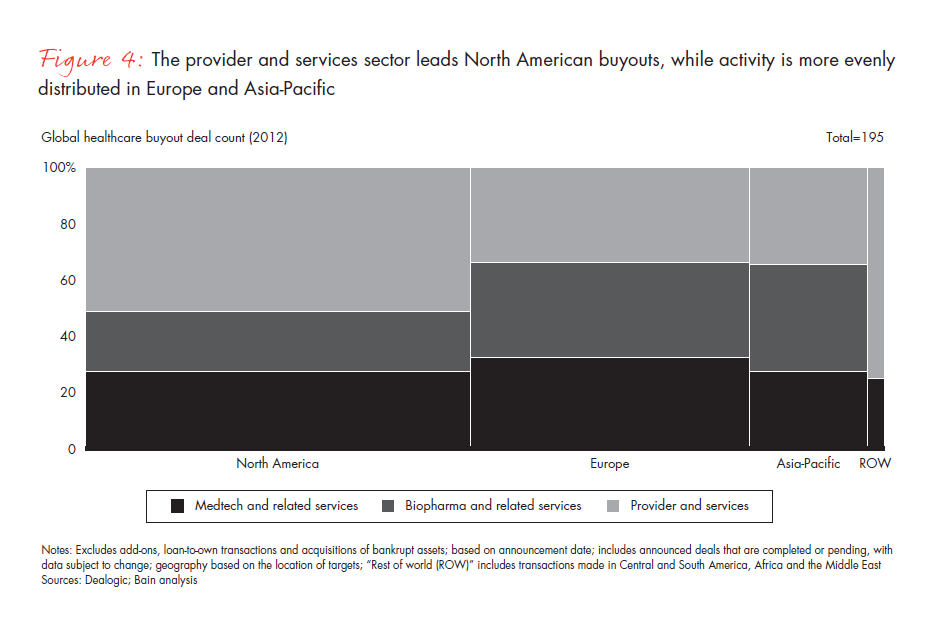
North America
Section highlights
- Macro pressures and a changing regulatory environment motivate healthcare organizations and insurance companies to sharpen their focus on cost reduction and outcomes
- Many investors flock to “healthcare light” subsectors like retail health, which do not face direct reimbursement risk
- Top returns will likely come from “healthcare heavy” sectors, which reward risk taking and industry-specific expertise
- Increased competition from strategic players crimps opportunities for large North American funds
- Canadian investors are also heating up the competition for healthcare deals
Macro environment. Healthcare private equity buyout activity in North America is dominated by the US, where both cost pressures and incentives to contain costs are robust. US healthcare spending as a percentage of GDP is far above most other developed countries, reaching nearly 18% in 2010. US-based employers, especially the larger employers that typically subsidize healthcare insurance for employees, have long been trying to contain their costs for pragmatic reasons. Legislative reforms—namely the Patient Protection and Affordable Care Act (PPACA)—are expected to accelerate the trend by creating more incentives for healthcare organizations and insurance companies to reduce costs themselves while improving outcomes.
One of the downsides of healthcare reform is the level of uncertainty it has created in the market as regulators work out the details of the sweeping legislation. Some clarity emerged in June 2012, when the US Supreme Court upheld the constitutionality of the PPACA. However, many details—for example, the nature and timing of state exchange openings, which states will expand Medicaid eligibility, the constitution of minimal essential health benefits, and the long-term funding and payment mechanisms for Accountable Care Organizations (ACOs)—remain in flux. In fact, many in the US are predicting an implementation delay for a number of the access reforms, given the lack of readiness of both states and commercial payers. This significant uncertainty weakens funds’ ability to invest against these themes with confidence.
Sectors and themes. For the most part, private equity investors in the US are looking to ride the trends that have been set in motion or accelerated by healthcare reform, such as cost containment, payment reform, new care-delivery models and hospital-physician alignment, without getting ensnared in the uncertainty about future reimbursement levels. That theme has led to meaningful increases in the number of deals within the provider and services categories with more limited or indirect reimbursement risk, such as retail health, healthcare-related IT and outsourced services; however, an influx of new entrants in these “healthcare light” sectors is leading to increased valuations and trickier return equations. Investors also continued to dig for under-the-radar pharma and medtech categories poised to benefit from reform trends but less exposed to reimbursement risk.
At the same time, there is a small but distinct segment of firms that has shown itself to be willing to invest in “healthcare heavy” deals that include reimbursement risk. Within the provider space, these firms made investments in practitioner aggregation spaces (particularly classic ones like anesthesiology physician practice management businesses), where reimbursement has generally been more protected. Other investors have made contrarian or longer-term plays on subsectors such as home health and also are looking aggressively at accountable care and independent practice association (IPA) plays. Some firms are continuing to look to pharma and medtech, compelled by the potential for lucrative strategic exits, such as OraPharma (to Valeant Pharmaceuticals) and Aspen Surgical (to Hill-Rom). Private equity investors are hoping that 2013 creates more opportunities for carve-outs in the sectors, like Johnson & Johnson’s recent announcement of its intention to spin out its Ortho Clinical Diagnostics business (see sidebar below, "Carve-outs drive activity in the US, while sponsor-to-sponsor transactions are more prevalent in Europe").
Who is investing. Strategic activity was strong in North America, making it difficult for large funds to find actionable targets of meaningful size. As a result, small and midsize funds were by far the most active funds, comprising approximately 70% of buyouts in North America in 2012. Many deals completed in 2012 were also done by firms that have not historically spent as much time in healthcare investing. The implication: In order to unlock top-tier deal returns, funds are going to have to work harder and more creatively in North America to find assets, price them appropriately and create value post-close.
Canadian investors are also heating up the competition for healthcare firms in the US. One example of their interest: Teachers’ Private Capital, the private equity arm of the Ontario Teachers’ Pension Fund, bought a majority stake in US-based Heartland Dental Care in one of the year’s 10 largest healthcare buyouts.
Europe
Section highlights
- Looming government budget cuts and ongoing healthcare reform continue to create uncertainty for investors
- Healthcare private equity deal volume stays relatively fl at due to supply constraints
- Two investment themes persist in 2012: acquisition roll-ups and avoidance of direct reimbursement risk
- Large European funds are behind most of the biggest deals in the region
Macro environment. As in North America, cost pressures are shaping investment themes throughout Europe, though in slightly different ways than in the US. In Europe, these cost pressures are creating various types of uncertainty about how much government funding will be available for healthcare in the future. In some countries, such as Spain, Portugal, Italy and Greece, the uncertainty is fueled by government financial woes and the looming budget cuts that will be necessary to help repair them. In many of the larger countries, the uncertainty stems from ongoing reforms that could affect the level of healthcare spending in unpredictable ways. The UK, for example, continues to digest the first year of healthcare reforms from the Cameron administration.
In addition to reform uncertainty, private equity healthcare deal volume in Europe has seen little growth because of two supply constraints. For one, many public companies have restructured their operations in recent years and completed their plans to carve out assets in the region (see sidebar below, “Carve-outs drive activity in the US, while sponsor-to-sponsor transactions are more prevalent in Europe”). Second, the family-owned businesses that have historically driven deal supply are waiting on the sidelines, in part because owners are not looking for liquidity to reinvest elsewhere at this time.
Sectors and themes. Investment activity in Europe last year was balanced across the three major sectors: pharma, medtech and providers and services. One common investment theme that played out during the year was the roll-up strategy. For example, BC Partners acquired Germany-based pharma company Aenova Group from Bridgepoint, with plans to continue a buy-and-build strategy. Within months of the acquisition, Aenova acquired another complementary firm in Germany. Pan-European expansion—acquiring assets that have been sufficiently consolidated within one country and extending the model across the continent—was also popular. For example, Advent International acquired Mediq, a Dutch pharmacy and medical supply firm, which has been expanding throughout Europe and into the US. This cross-border expansion can not only provide an upside in procurement and administrative operations but also help mitigate the risk of an individual health system’s impact on the asset.
Another common theme was the avoidance of direct reimbursement risk. Within the provider and services segment, funds made investments in sectors like nursing homes, labs and fertility clinics, which are relatively insulated from potential reimbursement cuts. Somewhat surprising, the reimbursement regime in Europe also offers some upside potential in the form of assets with low valuations that likely face stable reimbursement levels, or those that are not fully dependent on direct reimbursement. In other cases, reimbursement umbrellas, or very generous local reimbursement levels, provide opportunities for efficient private players in the provider space to maximize returns, resulting in buyouts such as the Carlyle Group’s acquisition of Ameos Group in Germany.
Who is investing. While large European funds like BC Partners and EQT are doing most of the largest healthcare deals in Europe, large US funds, including Advent International and the Carlyle Group, are also investing in the region. Middle market European funds, such as HgCapital and Montagu, typically have a lock on the rest of the deals on the continent.
Asia-Pacific
Section highlights
- Overall private equity investment in Asia-Pacific is down from 2011, but healthcare is a bright spot
- Outside a few buyouts, the majority of investments continues to be in the form of growth equity or private investment in public equities (PIPEs)
- In China, biopharma continues to draw the majority of investments, largely from local funds
- In India, global funds dominate and continue to focus on the provider space
- 2012 sees investors branch out from Singapore and begin exploring other key Southeast Asian markets
Macro environment. The Asia-Pacific region continued to see growing interest from healthcare private equity investors in 2012. Both buyout volume and value grew relative to 2011, even as overall private equity investment in the region remained fl at to down. The majority of investment activity was focused on China and India, followed by Australia (largely driven by KKR’s acquisition of Genesis Health). While transactions in Southeast Asia were limited in 2012, the region saw—based on Bain client engagements—a notable increase in private equity interest.
Sectors and themes. In China, overall private equity activity was down relative to 2011 amid concerns around the slowing economy and uncertainty about the country’s leadership transition. Healthcare, however, was a bright spot, displaying significant growth over 2011. In particular, the biopharma sector continued to see the majority of investment. Globally, three of the 10 largest biopharma private equity transactions in 2012 involved Chinese targets (Luye Pharma, 3SBio and Shaanxi BiCon). These three represent a mix of specialty pharma, traditional Chinese medicine and biotech drugs, catering primarily to the domestic market. The medtech and provider sectors also started to see some early investor interest in 2012, thanks to government support for medtech in the most recent five-year plan and the relaxation of foreign direct investment restrictions in the provider space. Interest is expected to grow in these sectors in 2013.
In India, too, overall private equity activity was down sharply, given the macroeconomic slowdown, dramatic depreciation of the rupee and continued stock market volatility; however, the healthcare sector saw an all-time high in activity. The majority of Indian healthcare private equity activity over the last few years has been focused on the provider space, and 2012 was no different. Deals in this sector fell into two camps: expansion capital for established formats like hospitals and nursing homes, and investments in innovative new formats like retail medicine concepts (for example, dental or vision) and other specialty medical centers. One example of the latter: The Government of Singapore Investment Corporation took a minority stake in Vasan Healthcare, a specialty eye and dental care company. Although there was venture capital activity in the Indian pharmaceutical sector, private equity investments were low due to heavy existing regulations and uncertainty around future regulations. Private equity interest was also relatively low in the nascent local medtech sector, although low-cost medtech and medtech services firms gained some attention, as evidenced by Fidelity Growth Partners’ acquisition of a stake in medical equipment distributor Trivitron Healthcare. (For more on healthcare investment trends in India, see Bain & Company’s forthcoming India Private Equity Report 2013, due out later this year.)
Historically, Singapore has been the primary destination of private equity investment in Southeast Asia. In 2012, however, investors looked seriously at other key markets in the region, namely Indonesia, Thailand, Vietnam and Malaysia, particularly within the provider (hospitals and clinics) space. While transaction activity across the region was low in 2012, we anticipate this sector to continue to be on the radar of major investors in the area.
Australia also continues to be an attractive area of investment for private equity investors, given the favorable macro trends and under-penetration of many private healthcare offerings. One example last year was KKR’s investment in Genesis Health, a leading provider of radiation oncology and cardiology practices.
Who is investing. Outside of a few buyouts, the majority of investments in Asia-Pacific continued to be middle market growth equity and PIPE investments. Like the broader private equity market in China, local funds were a lot more active in the healthcare space than global funds, despite easing restrictions on foreign investment. Competition for assets from corporate buyers in China is also growing. Multinational companies are looking to acquire platform assets in emerging markets, evidenced by Medtronic’s $816 million3 acquisition of China Kanghui Holdings (closed in November 2012) and Stryker’s $764 million4 offer to acquire Trauson Holdings (closed in March 2013) in the China orthopedic market. Local healthcare companies are also starting to see M&A as a key growth lever. This growth in strategic interest increases competition but also presents an attractive exit path, as both Kanghui and Trauson had minority private equity investors.
In India, the landscape is quite different. Consistent with the overall private equity market in the country, the majority of investments were made by global funds; local funds focused only on a few smaller deals. These global funds are also active in secondary transactions in the region, as evidenced by Fidelity Growth Partners’ investment in Trivitron Healthcare.
Across the region, sovereign wealth funds have been active in this space over the last few years, with deals including Khazanah Nasional’s $2.6 billion5 buyout of Parkway Holdings in Singapore in 2010 and Temasek’s $300 million6 investment in Shanghai Pharma (along with Bank of China Group Investment and other investors) in 2011. In 2012, they made only a few small investments, but going forward, we expect them to play a more active role in the healthcare space.
3. Sector trends
Provider and services sector leads healthcare investment activity
Section highlights
- Driven by macro pressures to contain healthcare costs, provider and services overtakes medtech as the most popular sector by value in 2012
- Consolidation strategies are popular in both Europe and the US, as investors look to aggregate small players in fragmented markets
- Pan-European expansion is an investment theme most pronounced in Europe, while the growth of accountable care organizations is an investment angle unique to the US
- “Healthcare light” subsectors like retail health continue to be popular, but some investors are willing to pursue more complex “healthcare heavy” sectors
The provider and services sector, which includes healthcare-related IT (HCIT), overtook medtech as the most popular sector in 2012 (see Figure 5), with more than 80% of the action occurring in Europe and the US. Companies in the provider and services sector captured approximately 53% of 2012 private equity healthcare deal value and 43% of the deal volume. A number of those deals were sizeable, with the sector comprising half of 2012’s largest deals. For the most part, though, smaller deals remained the “sweet spot” for this sector. For example, the median check size for US deals was $163 million.
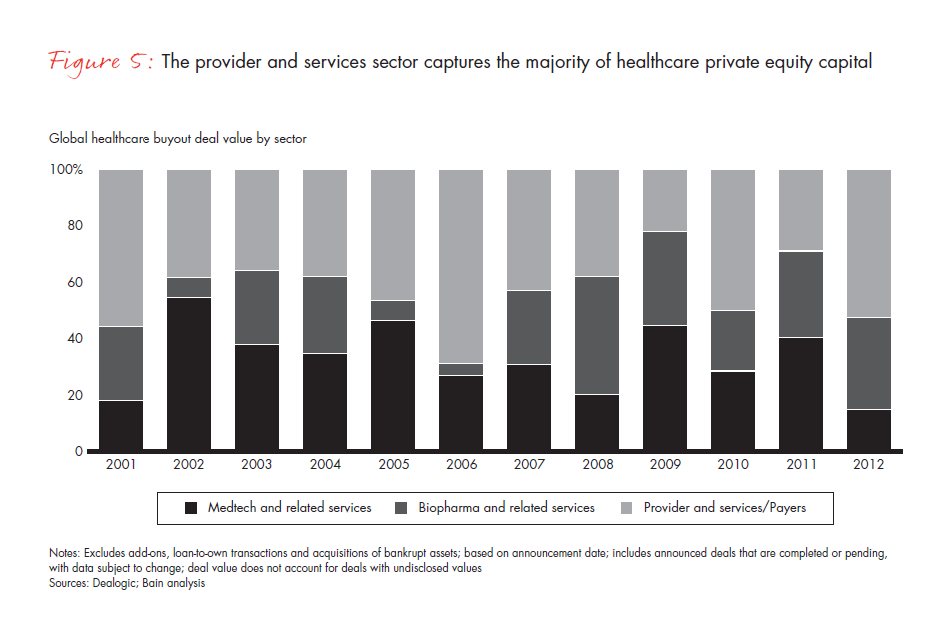
The driving force behind the interest in this space is a long track record of attractive returns, coupled with manageable downside risk across many subsegments. While it will likely continue to be an area of “good credit” for investors, strong returns may be harder to achieve in the future without additional efforts.
Both in Europe and the US, a key investment theme within provider and services is consolidation. In both regions, investors are looking to aggregate small players, particularly in highly fragmented subsectors, in order to capitalize on the benefits of local relative market share and scale operational efficiencies. “Healthcare light” subsectors like retail health—or those with less reimbursement and regulatory risk—are particularly appealing because they are relatively easy to value and enter, even for investors lacking expertise in the industry. Even among experienced healthcare investors, competition is fierce, as evidenced by the large number of bidders competing for companies like Heartland Dental Care and CHG Healthcare Services. In the US, dental, urgent care and vision clinics are popular, as are veterinary clinics in Europe. Given the price points paid for these leading retail health assets, it is absolutely paramount for investors to have a robust “retail playbook” (e.g., optimizing the box and rolling out the footprint) to execute post-close.
At the same time, there are some areas in both regions where investors are willing to take reimbursement risk and invest in “healthcare heavy” deals. In the US, some investors made bold bets on home care, a sector likely to be favored by payers in the long run. Others took chances on physician aggregation (e.g., Welsh, Carson, Anderson & Stowe-backed US Anesthesiology Partners), especially where there was an opportunity to consolidate local markets via M&A and build scale to protect their reimbursement levels. Investors are now moving beyond traditional hospital-based physician practice management opportunities to evaluate office-based plays, as evidenced by Audax Group’s investment in dermatology (via Advanced Dermatology and Cosmetic Surgery). In Europe, some investors pursued private hospitals, such as Carlyle Group’s acquisition of Ameos Group in Germany, to take advantage of reimbursement “umbrellas,” or pockets of opportunity where government reimbursement levels are generous enough to allow for some profit potential from efficient operations. Unlike the more popular “healthcare light” plays, these “healthcare heavy” subsectors require deep industry experience as well as a solid grasp of regulations and reimbursement trends to unlock meaningful returns. Interestingly, the vast majority of respondents in a survey of Healthcare Private Equity Association (HCPEA) members expressed willingness to take on reimbursement risk, even though this type of deal represented a small portion of total deals in the provider and services sector in 2012. Going forward, this willingness will be increasingly important for successful returns, given the level of competition and high prices for “healthcare light” sectors.
One investment theme that is most pronounced in Europe is pan-European expansion. This theme is frequently present in provider and services investments, as it can help reduce an asset’s exposure to a single health system in addition to offering potential efficiencies in procurement and administrative operations. Beyond the buyout of pharmacy and medical supply firm Mediq, labs and nursing homes are popular segments for pan-European expansion plays.
An investment angle that is unique to the US is the aim of capitalizing on the growth of accountable care organizations (ACOs). Investors are seeking ways to play ACOs across the value chain, from direct investments in IPAs or hospitals to more derivative service plays like care management and HCIT (see sidebar below, “Data and analytics firms lead HCIT investments due to a growing focus on healthcare cost containment”). With respect to IPAs, the bright spot is that there are many local scale assets to consider as potential platforms. The challenge will be the amount of work ultimately required for a private equity investor to get a deal done, given the nature of physician groups, the questions around scalability beyond existing geographies, and the level of strategic competition (as evidenced by the DaVita/HealthCare Partners and Humana/Metropolitan Health deals). On the services and HCIT front, the draw is that providers will have a real need for new capabilities to help them succeed as accountable care organizations. The challenge for investors is that they will either need to place bets on assets with a legacy business that they can pivot to a broader ACO offering or invest in more “venture-like” companies.
High interest in payer space but few deals
Section highlights
- Despite strong interest, little private equity activity materializes in the healthcare payers sector due to robust strategic presence and lack of certainty around US healthcare reform
- Specialty benefits management companies and brokers draw particularly high levels of interest from investors
The payer and associated services sectors, which include a range of subsectors, such as insurance companies, brokers, audit services and specialty benefits management companies, are generating strong interest but little activity among private equity investors. This is mostly a result of stiff competition from strategic players and lack of clarity around who will be the winners and losers following US healthcare reform. The universal theme that unites companies in this space is their aim to contain costs and improve outcomes for patients. In general, the interest is concentrated in the US, where the insurance system and healthcare reform regulations create a large need for these firms. The sector is mostly dormant in Europe, where federal governments control the majority of healthcare funds, though it is likely to evolve over the next decade in Asia-Pacific and the rest of the world as private health insurance markets in those regions mature.
There have been very few private equity-backed healthcare-specific payer deals over the last decade. One reason for the low number of direct payer investments among financial sponsors is that many payer businesses like insurance are hard to enter because of large capital requirements and complex regulations. In addition, many private equity investors who want to play the cost containment angle have been focusing on the provider and services sector, including HCIT. Firms in that space can infl uence patient outcomes more directly (as opposed to the indirect means available to payers) and have taken an increasingly large role in improving those outcomes. Finally, some buyouts that touched on the healthcare insurance space have their primary businesses in other markets, excluding them from industry deal counts.
Specialty benefits management, including group health and workers’ compensation, saw exceptional interest from private equity healthcare investors in 2012, with workers’ compensation particularly active. While there were no pure private equity-backed buyouts in the space, the merger between two private equity-backed companies, One Call Medical and MSC, is one example of this trend. There was also a surge in interest in brokers late in the year, including the acquisition of Alliant by KKR from Blackstone announced in November, as investors made bets that public markets are undervaluing the upside that brokers will eventually see from state health insurance exchanges under healthcare reform. Finally, the “fraud, waste and abuse” space attracted interest, evidenced by Advent International’s strategic growth investment in Connolly, a leading provider of technology-enabled recovery audit services to multiple industries, including healthcare.
In 2012, strategic activity in the payer sector was dominated by payers acquiring more substantive positions in government segments. Examples include Aetna’s acquisition of Coventry and WellPoint’s acquisition of Amerigroup. Payers were also active in buying providers (for example, a consortium of not-for-profit Blues plans partnering with Lumeris to acquire Navinet). In 2013, we expect to see more of this type of payer growth and diversification. This will make the road more challenging for private equity investors in the payer and payer-related spaces.
Popularity of biopharma continues as more funds are willing and able to price its risk
Section highlights
- Biopharma continues to generate interest from private equity investors, maintaining a 33% share of deal value
- Investors focus on roll-up strategies that involve buying related and complementary assets to create broad platforms that would ultimately be attractive to strategic buyers
Biopharma was the second-most popular sector last year, representing approximately 33% of overall healthcare private equity deal value, about the same as its share in 2011. This sector maintained its position as more funds came to the market willing and able to price the risks associated with it. Still, the majority of deal value within the sector came from transactions in the pharmaceutical space rather than biotech, since the mature end of pharma (in the form of branded generic and over-the-counter drugs) tends to be easier to price and brings a more reliable revenue stream. To further increase predictability, most investors are looking for mid-stage assets, or a mixed portfolio of assets, that offer both a track record and some upside potential.
Notable deals included TPG’s acquisition of Par Pharmaceutical (which includes both a generic drug division and a proprietary drug division) for $2.2 billion8 and Cinven’s purchases of Mercury Pharma Group and Amdipharm for $730 million9 and $590 million10, respectively, with the intent of merging them. As the latter deals illustrate, investors in the biopharma sector are heavily focused on roll-up strategies that involve buying complementary assets to create broad platforms that would ultimately be attractive to a strategic player. There were also small, mid-market deals done in more protected niches, like Warburg’s acquisition of sterile injectables maker JHP Pharmaceuticals. Consolidation potential also exists in the pharma contract manufacturing organization (CMO) subsector, where smart investors can create value by combining leftovers from pharma spin-offs in a manner that fits with customer needs and maximizes asset utilization. On the biotech side, the largest transaction in 2012 was a consortium deal between existing management and CITIC to acquire 3SBio for approximately $350 million11.
Looking ahead, biopharma investors will need to be creative about the assets they select and how they combine them. In many cases, unlocking the value in available assets will require a turnaround mindset and difficult moves, such as streamlining the workforce, restructuring therapeutic areas and merging assets in unconventional ways. Funds that have the skills to make such transformational changes will thrive. Historical deal returns suggest that pharma is a very worthy area of focus for private equity investors.
Medtech characterized by opportunistic mid-market activity by private equity funds
Section highlights
- Medtech, the most popular sector in 2011, sees a significant decline in deal value in 2012
- Strategic players are very active in this sector and will likely remain so for the foreseeable future
- Many subsectors within medtech are seeing price declines and commoditization, creating opportunities for private equity investors to unlock value
One of the biggest changes in 2012 was the decline in deal value within the medtech sector. As the most popular sector of 2011, medtech captured 40% of overall healthcare private equity deal value; last year, that fell to only 15%. The main reason for the slide was not lack of interest, but rather a lack of scale assets available. In addition, investors captured far fewer large deals in this space compared with 2011, when Apax Partners bought KCI for more than $6 billion12 and TPG acquired Immucor for about $2 billion13.
Of the medtech deals that occurred in 2012, most focused on product companies rather than services firms. The largest deal in the sector was EQT Partners’ 71% stake purchase of wound- and injury-care product manufacturer BSN medical in Germany for $1.6 billion14. This, along with a few smaller regional deals, illustrates that the wound-care subsector continues to be an area of investor interest following the 2011 buyout of woundcare specialist KCI. Other product deals spanned subsectors such as equipment (e.g., diagnostic and imaging), implants (e.g., dental and orthopedic) and supplies. On the services side, there were only a few small deals focused on niche medtech CMO and lab companies, a contrast to the larger deals seen in these areas in the past.
Strategic players have been very active in the medtech sector, accounting for 92% of deal volume in 2012, and will likely remain active for the foreseeable future. Both Boston Scientific and Covidien made multiple major acquisitions in this space, which signaled their appetite for innovation. Other large strategic deals included Japan’s Asahi Kasei’s $2.2 billion15 acquisition of US-based Zoll Medical.
Despite the stiff competition from strategics, however, we believe medtech deserves a closer look by private equity investors. Many markets within this sector are seeing price declines and commoditization, creating opportunities for investors with industry knowledge to employ “low road” strategies by improving performance and preparing their salesforce to face the rising crop of value-conscious buyers. Going forward, private equity firms will likely find their best values within unconventional categories, such as under-the-radar assets, assets needing a turnaround, assets that would be hard for a strategic firm to integrate and lower middle market deals.
4. Cross-sector trends
Mega-fund activity slows
Section highlights
- In 2012, a large group of midsize funds displaces larger funds as the primary driver of investment activity
- Funds of all sizes focus on providers and services, where fragmented markets offer attractive roll-up opportunities
- Facing formidable competition from strategic players, mega-funds show greater interest in middle market opportunities
A large group of midsize funds drove investment activity in 2012, rather than the larger funds that dominated the previous year, when supersized deals were more common. For example, in the US, funds with less than $1.5 billion under management accounted for 71% of investment activity in 2012, compared with 56% in 2011 (see Figure 6). Meanwhile, mega-funds (those with $4.5 billion and more under management) saw the greatest decline, decreasing from 26% of investment activity in 2011 to 15% in 2012. Funds of all sizes focused on the provider and services space, where fragmented markets offer many roll-up opportunities.
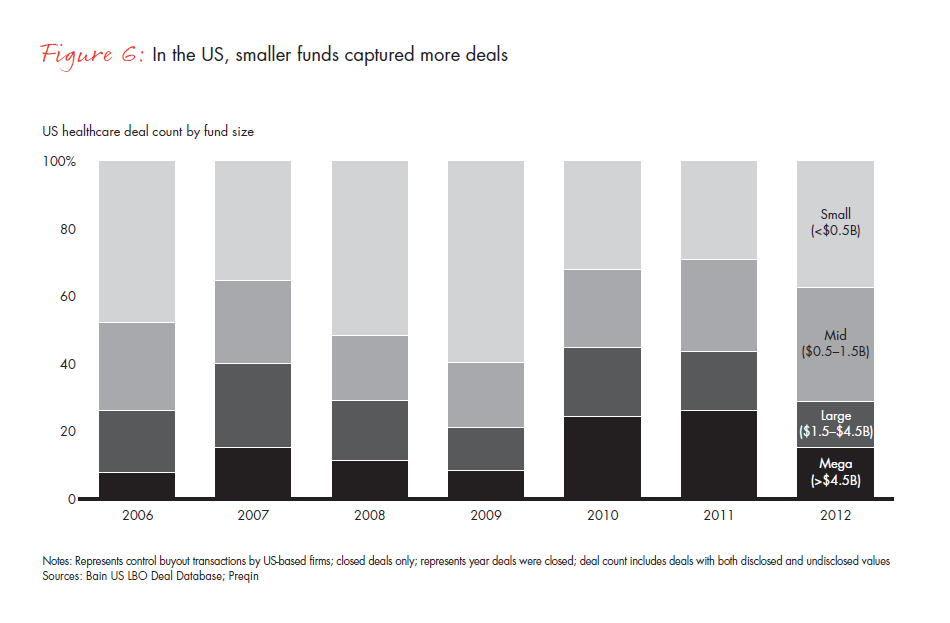
While mega-funds are continuing to pursue large deals, as illustrated by the buyouts of Par Pharmaceuticals and BSN medical in 2012, they face formidable competition from strategic players. As a result, they are showing greater interest in middle market opportunities, which is the “sweet spot” for many of the attractive service deals. In order to pursue these opportunities, some mega-funds will have to take a hard look at whether it is worth lowering their traditional minimum-equity check size to bid for these deals. This strategy is likely to make the most sense in “healthcare heavy” subsectors that demand both capital and expertise, particularly when the asset could be the cornerstone of a broader consolidation play. At the same time, mega-funds should not overlook the opportunities within pharma and medtech that also require specialized knowledge, particularly since the larger deal opportunities in those sectors can better leverage their scale and resources.
Strategic buyers continue to have a strong presence in all sectors
Section highlights
- Strategic acquisitions continue to drive the majority of healthcare deal activity
- In the last two years, provider and services is the fastest-growing sector for strategic activity
- In many cases, the presence of strategic investors leads to increased competition for assets; at the same time, they also can create attractive exit options for private equity-backed companies
Strategic buyers were a major presence in every healthcare sector in 2012, acquiring assets from private equity firms, each other and other sources to create growth. But even their purchases declined relative to 2011. Altogether, strategic and financial buyers created approximately $172 billion worth of mergers and acquisitions within the global healthcare industry in 2012, down from the $217 billion and $224 billion seen in 2010 and 2011, respectively (see Figure 7).
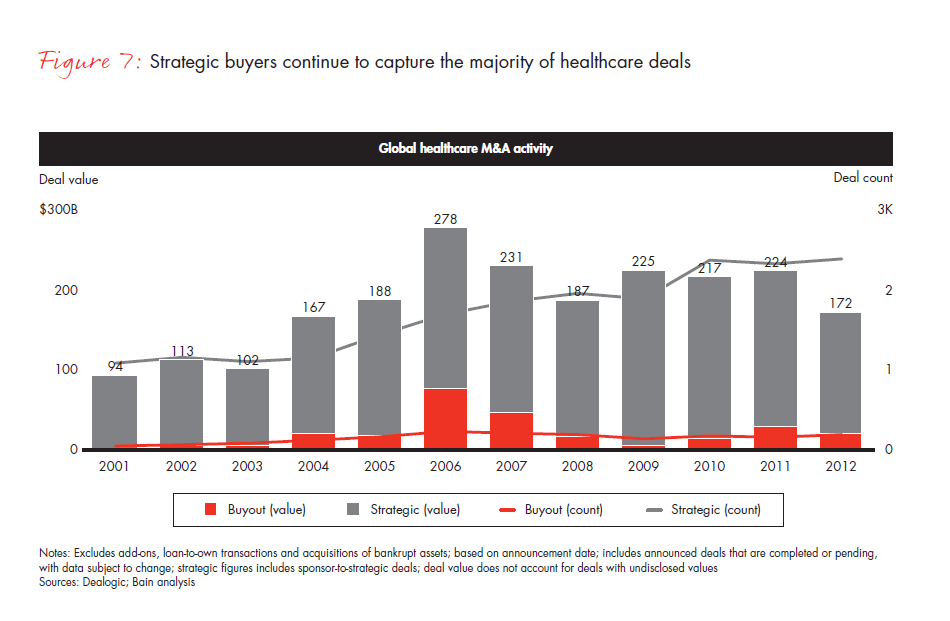
Still, strategic players have been a dominant force in all sectors and are growing in the provider and services sector faster than in any other in the past two years (see Figure 8).
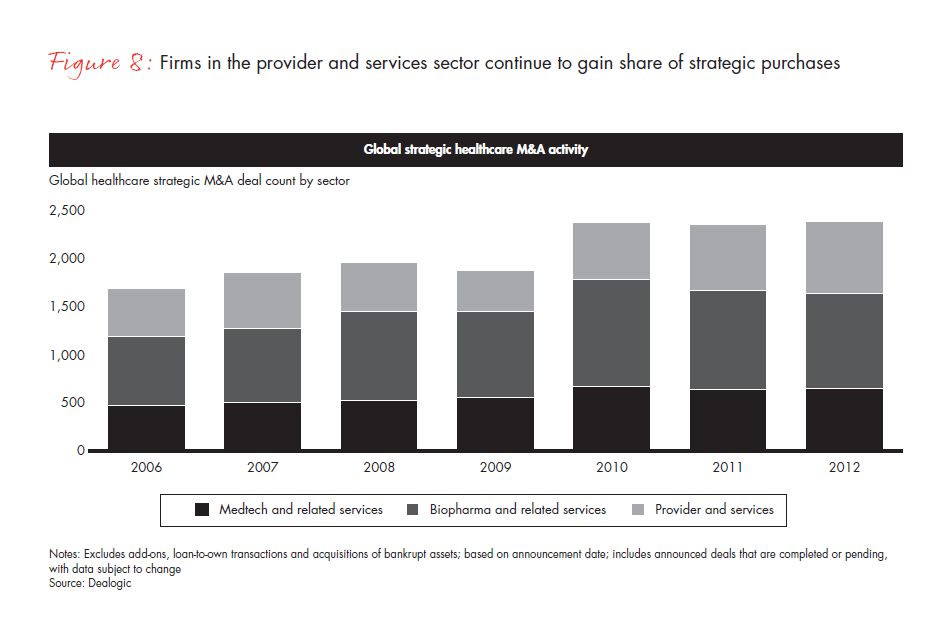
Within pharma, strategics have focused on adding new products, especially specialty lines, rather than infrastructure. Valeant Pharmaceuticals, for example, made more than 10 acquisitions in 2012, including the purchase of private equity-backed OraPharma, in order to make its first foray into the oral care market. Corporate purchases in the medtech sector have followed a similar theme, with Boston Scientific and Covidien making multiple (and large) bets on next-generation technology firms. Going forward, geographic expansion is likely to be a feature of medtech acquisitions, as foreshadowed by Medtronic’s purchase of China Kanghui Holdings and Stryker’s purchase of Trauson Holdings. In general, implants and equipment manufacturing will be best positioned for this type of activity.
Within the payers and provider and services sectors, corporate buyers made a number of notable investments in 2012. In the US, payer and provider firms are increasingly focused on aligning themselves with accountable care and healthcare reform trends. DaVita, one of the country’s largest dialysis providers, made a bold bet on this trend by acquiring HealthCare Partners, the owner of multiple physician groups and IPAs, for more than $5 billion16.
Two large insurers—Aetna and WellPoint—both struck deals with similar price tags to buy other insurers (Coventry and Amerigroup, respectively) that offered them better footholds in the Medicare and Medicaid markets. In addition, in the US, the lines between payers, hospitals, medical groups and other delivery system assets continue to blur. Payers are forward integrating into primary care and full-fl edged health systems, while providers like Dignity Health, with its acquisition of US HealthWorks, are broadening their capabilities.
Pent-up demand for exits grows
Section highlights
- After falling in 2011, exit activity rises slightly in 2012
- Sponsor-to-strategic sales accounts for the majority of exit transactions across all sectors
- Historical buying and selling patterns suggest that there is likely a strong pent-up demand for exits
Exit activity rose slightly in 2012 after falling in 2011. Private equity investors sold 99 healthcare firms from their portfolios this year, slightly up from 95 in 2011, but down from 114 in 2010 (see Figure 9). The slow rebound is not surprising, considering that the capital markets, including the IPO market, remained fairly locked up during the year. Many funds also face internal barriers, including portfolio assets that are still recovering from the global recession, and the need for consensus from multiple partners in syndicated deals.
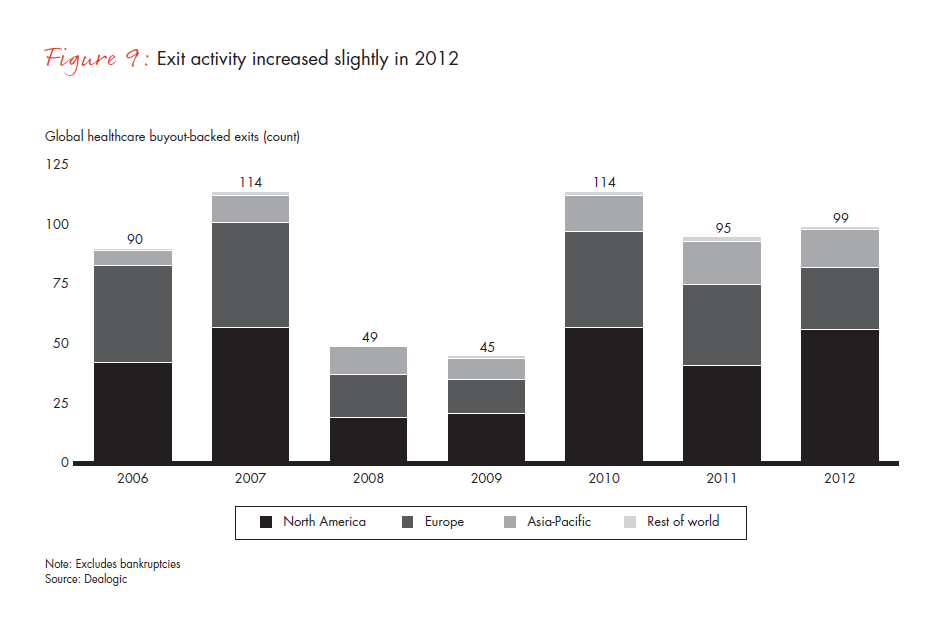
Strategic buyers were a boon on this end of the market (see Figure 10), accounting for 75% of the exit transactions globally within the pharma and medtech sectors. They also comprised the majority of buyers within the provider and services sector, though financial buyers accounted for a healthy 44% of exits there as well. Strategic buyers also took the lead on the larger deals, capturing 60% of sponsor exits with price tags of more than $1 billion, including DaVita’s acquisition of HealthCare Partners for more than $5 billion17 from management, physician partners and Summit Partners. IPO exits in 2012 were generally small; the next largest IPO exit after IHH Healthcare for more than $2 billion18 was Globus Medical for $115 million19.
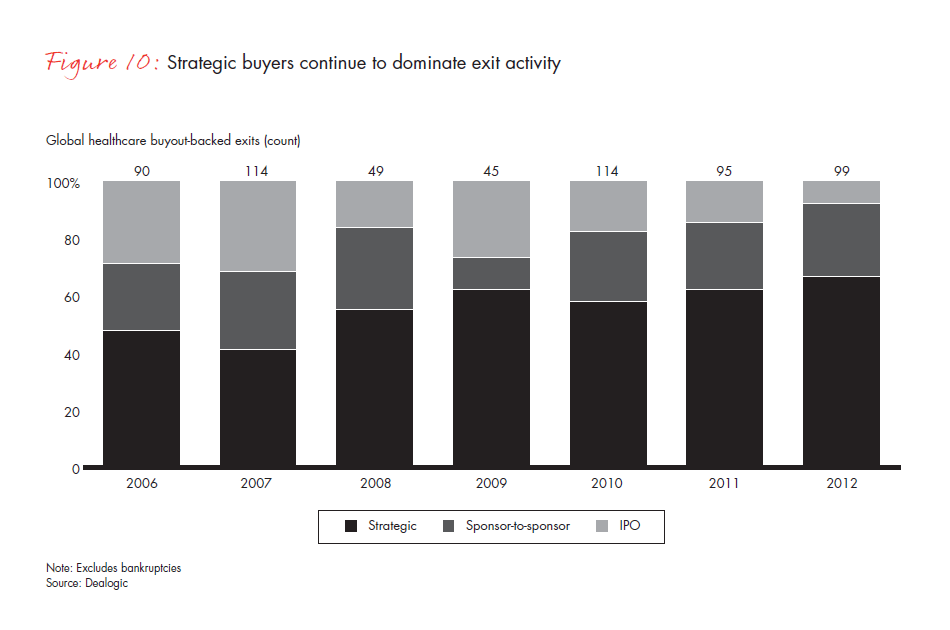
Looking at buying and selling patterns over time, there is likely a strong pent-up demand for exits, as investment activity has significantly outpaced exit activity over the last six years. Since 2006, private equity firms globally have made more than 1,300 healthcare buyouts but only approximately 600 exits. While exit figures may mask some under-the-radar activity, including firms that are combining assets within their portfolios as well as bankruptcy filings, it is clear that there is a large crop of assets from 2006 and 2007 coming to maturity. In fact, private equity firms responding to a recent HCPEA survey reported holding deals longer than originally anticipated in order to meet targeted cash-on-cash returns.
The question is, when will exit activity pick up? In the survey, most respondents reported expecting exit activity to pick up in 2013 or 2014. We expect exits to pick up in the same time frame given growing pressure from the 2006 and 2007 vintages; however, the timing of the spike will likely be driven by improvements in the IPO market or financing terms. In the meantime, investors should be vigilant about creating value in their portfolio companies in order to maximize the potential return at exit (see sidebar below, “The growing importance of alpha”).
The search for returns: Opportunities across sectors
Section highlights
- There are top-quartile deal returns across all sectors
- The proportion of medtech and pharma investments that yield top-tier returns greatly exceeds that of provider and services
- Investments in the medtech and pharma sectors require significant expertise to appropriately value reimbursement risk and cost reduction opportunities
Returns are down in all sectors, but some sectors still tend to outperform others. For example, Cambridge Associates data on returns indicates that pharma has delivered the highest or second-highest returns in nine of the last 15 years (see Figure 11).
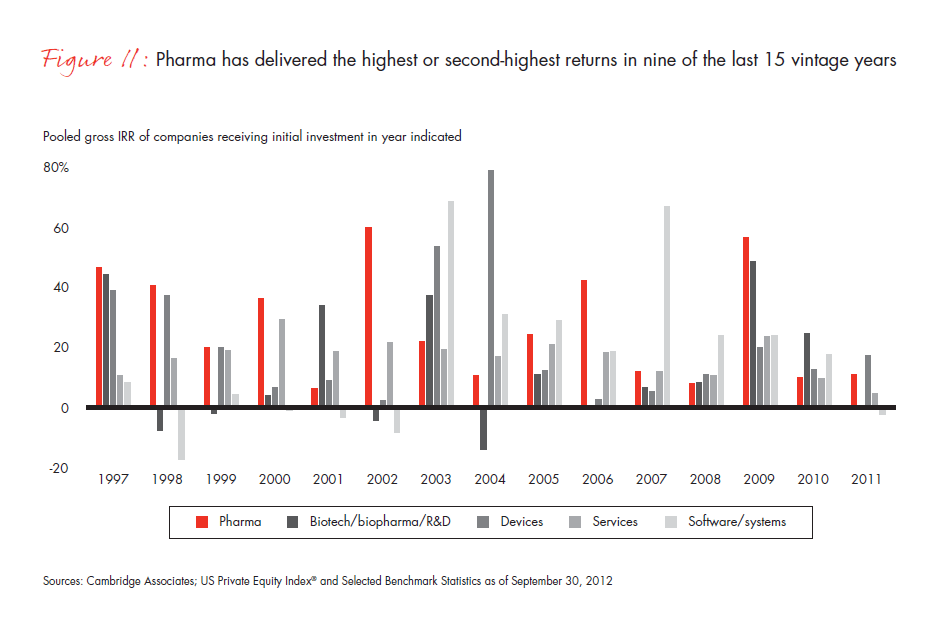
Looking at reported exit multiples, the proportion of medtech and pharma assets that proved to be top performers was higher than those in the provider and services sector, where high earners were the exception rather than the rule (see Figure 12).
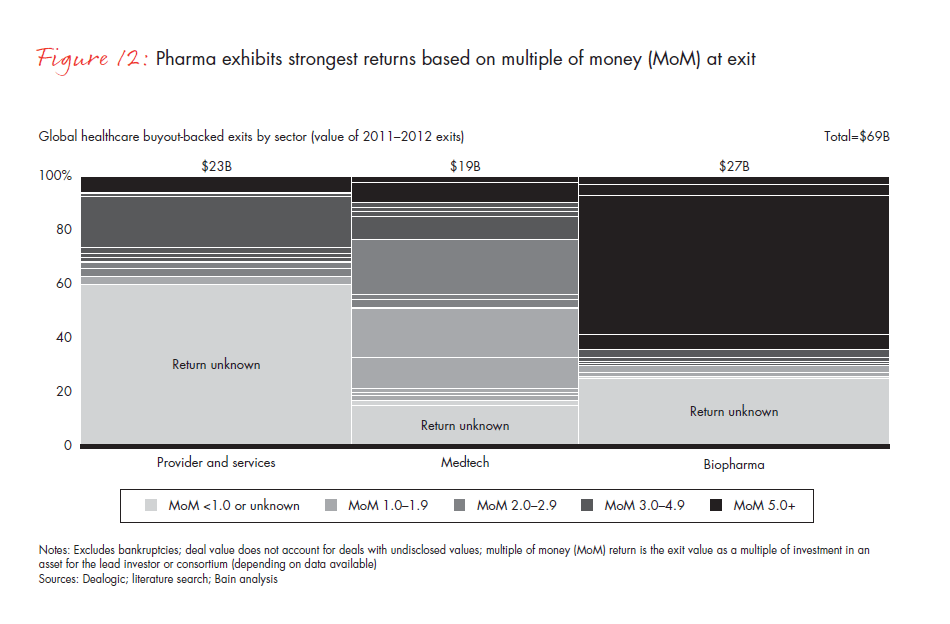
Perhaps the key reason for higher returns in medtech and pharma is that the strategic players in those sectors also tend to be excellent buyers—a fact that should help limited partners (LPs) accept such deals. Recent examples of this phenomenon include Baxter’s acquisition of Gambro, which earned Investor AB—a 49% owner of the company—a reported 19% IRR. That trend continued into 2013, when CBPE Capital sold Rosemont Pharmaceuticals to Perrigo Company and earned a reported 3.25 times return on its initial investment. In contrast, while there is strong strategic activity in the provider and services market, many of its assets are better suited for an IPO exit or sponsor-to-sponsor sale.
The caveat to investing in medtech and pharma is that it is not easy for all funds to attain these higher returns. These sectors tend to require specialized expertise and carry risk profiles that make many LPs uncomfortable. In fact, in a survey of HCPEA members, firms reported plans to spend only 5% of their efforts in 2013 in the pharma/ biotech sector and less than 11% in medtech. That said, for investors who are willing to take the risk, potential rewards are high.
Investors who want to create alpha in these competitive yet lucrative sectors must have strong diligence capabilities (see sidebar below, “Finding the best assets is only half the battle”). In addition, they should be careful not to overlook two critical steps in their diligence processes. For one, there should be a much stronger focus on reimbursement risk than there is in the provider space. Since the market for any given medtech or pharma company is generally concentrated around a small number of products, these firms are inherently more vulnerable to changes in reimbursement status, especially if newer or better products come along. Secondly, it is essential to focus on how well a medtech or pharma company is using its large fixed assets, since many of those assets are hard to repurpose or sell off in order to cut costs.
5. Outlook for 2013
Section highlights
- Healthcare will remain an attractive space for private equity investments, but top returns increasingly will be found in the most complex deals
- Investors may need to reshuffle their investment strategies, weighing the right balance across healthcare sectors, geographies and complexity, and must remain on the lookout for attractive exit opportunities
- The winners will stay ahead of the competition in sourcing deals and remain involved in assets post-close to enhance return potential
Looking ahead, there is no question that healthcare investing remains attractive, thanks to the unique combination of stability and innovation it offers. But top returns will increasingly be found in the most complex deals, and striking these deals will require harder work and more creativity. Fortunately, some of the major drivers of the market are trending in investors’ favor. Debt is cheap, making it easier to finance deals, and the hunting ground is large. At the same time, the stock market is rebounding and the appetite of strategic buyers remains strong, portending more and bigger exits. These are ripe conditions for investors with healthcare expertise to achieve excellent returns if they choose the right opportunities.
Within the provider and services sector that was so popular in the past year, consolidation opportunities should remain plentiful. Healthcare reform in multiple countries is intensifying the drive toward better outcomes at lower costs. As more providers aim to get smarter about their operations, both in terms of supply chains and treatment outcomes, the skills that private equity investors bring to assets have an even greater role to play than they do currently. The competition will be most acute around “healthcare light” assets like retail health firms, bidding up their prices. One major caveat for mega-funds interested in these assets is that playing in this space will likely require dropping the minimum-equity check size and losing some scale and leverage. Complex “healthcare heavy” deals that have strong consolidation potential or other features that compensate for reimbursement concerns may make better use of their capital and expertise.
The two other major sectors within healthcare—pharma and medtech—require a different level of expertise and command a higher level of strategic activity than provider and services, giving deals in these areas stronger potential for outsized returns. Mega-funds, in particular, should be preparing internally to invest in pharma and medtech, as the large deals that tend to cluster in them represent the most efficient use of their capital. To succeed, investors in these areas must know the space well enough to evaluate how likely a pharma or medtech product is to be replaced or otherwise lose its reimbursement status. They also need to be able to accurately predict which costs can truly be cut within a firm before buying, considering that many of the fixed assets in these sectors tend to be highly specific and hard to repurpose or sell.
Healthcare private equity investors also need to get out their globes in order to get ahead in 2013 and beyond. While North America and Europe traditionally have offered a sufficient supply of attractive assets, it is becoming increasingly imperative to branch out to new geographies to gain a competitive advantage. For the moment, this means entering China, India and Singapore, where deal growth is likely to far exceed rates in more-established markets, but in the near future could include smaller markets such as Malaysia and Thailand. Established markets like Australia are also of increasing interest. Entering is not necessarily easy though, as competition is still strong from both local firms and other players.
The pace of exits remained slow in 2012; however, there are good reasons to expect it to pick up in the year ahead. On the supply side, a large crop of buyouts from 2006 and 2007 are coming to maturity. On the financing side, inexpensive debt and growing appetites within the equity markets and among strategic buyers should also bolster demand. Despite these positive factors, the fact remains that investors hoping to achieve top returns on their assets will have to work hard to find good exit situations for them.
While it may be more difficult to achieve top returns than in the past, there are still plenty of ways for creative and proactive firms to win. The basic elements of success—staying ahead of the competition in sourcing deals and driving alpha by remaining involved in assets post-close—will continue to serve private equity investors well. The most successful will deploy capital proactively behind key themes and also look beyond the high-multiple, high-growth opportunities of past years to seek contrarian or lower-growth value plays in turnaround situations where their expertise can drive alpha. Winners will find themselves on the right side of the coin if they can improve outcomes and lower costs, the ultimate goals for almost all healthcare businesses these days.
This report was prepared by Bain’s Healthcare Private Equity practice and a team led by Lauren Christman, a consultant in Bain’s Healthcare practice. The authors would like to thank Jennifer Long, Rahul Venkateshwara, Jerry Li and Matthew Jensen for their contributions; Brenda Rainey for her guidance; John Peverley for research assistance; and Alix Stuart for her editorial support. We are grateful to the Healthcare Private Equity Association, especially Karen Kajmo, Elizabeth Quadros Betten and Joseph Ibrahim, for their collaboration on this report. We are grateful to Dealogic and Preqin for the valuable data they provided for this report.
Carve-outs drive activity in the US, while sponsor-to-sponsor transactions are more prevalent in Europe
Reflective of the dearth of mega-deals, private equity buyouts of public companies were low in 2012. They represented less than one-quarter of all closed buyouts greater than $75 million in the US and less than 10% in Europe. In fact, of the top 10 global healthcare private equity deals announced in 2012, the majority were private-to-private, with six sponsor-to-sponsor deals and one carve-out.
In the US, carve-out transactions were the dominant deal type, representing almost 40% of closed buyouts greater than $75 million. In Europe, sponsor-to-sponsor transactions represented more than 40% of such buyouts. We anticipate that investors will continue to aggressively look for carve-out opportunities within pharma and medtech.
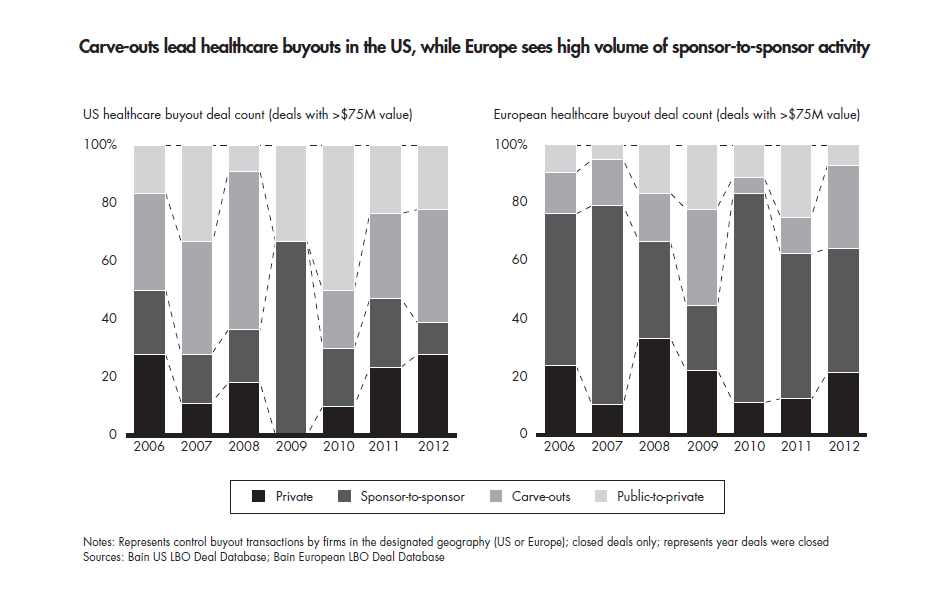
Data and analytics firms lead HCIT investments due to a growing focus on healthcare cost containment
One segment within the provider and services sector that was particularly attractive in 2012 was healthcare- related information technology (HCIT), representing nearly 17% of global deal volume within the sector. The vast majority of deals took place in the US and focused on a range of categories including data and analytics, transcription and speech recognition, electronic health records and alternate-site IT. At least two deals in this space were sizeable: Both One Equity’s investment in the transcription services fi rm M*Modal and Veritas Capital’s investment in Thomson Reuters’ data and analytics healthcare business each topped $1 billion7, together accounting for nearly 80% of reported HCIT deal value in 2012.
By volume, nearly one-third of deals within HCIT centered on firms that use data and predictive analytics to help contain healthcare costs. One such transaction was BV Investment Partners’ acquisition of Health Information Designs, which helps Medicaid agencies reduce waste and fraud. Firms that offer niche electronic health record (EHR) solutions were also popular, as shown by Thoma Bravo’s acquisition of SRS Software,which targets specialty areas like orthopedics and ophthalmology. Alternate-site IT also continues to be an interesting space, as evidenced by ABRY Partner’s acquisition of Source Medical, which targets ambulatory surgery centers, specialty hospitals and rehabilitation clinics.
With macro trends stoking interest, private equity firms responding to a recent survey of HCPEA members reported that HCIT is the most competitive sector in healthcare. Several factors prevented more private equity buyouts from coming to fruition, including extremely high valuation expectations and a fair amount of competition from strategic players. This strategic interest has continued into 2013, as evidenced by payer UnitedHealth’s acquisition of Humedica. As many markets mature, the bar is rising for investment behind firms that will be winners and will be able to weather any disintermediation threats from the major electronic medical record (EMR) vendors. The challenge is that in areas where the winners are clear, they are priced accordingly, and uncertainty about the viability of middle-of-the-road targets makes valuations difficult. As a result, private equity firms interested in the HCIT space must be thoughtful about the deals they pursue and creative about how to generate value in their targets. Adjacent growth vectors are an increasingly important component of the deal thesis, as many investors view this as a way to invest behind nascent market opportunities. This is evident in the arguably more-complex scale transactions that took place in 2012—M*Modal (evolving to EMRlinked speech recognition solutions) and Thomson Reuters’ healthcare business (evolving to predictive analytics and business intelligence).
The growing importance of alpha
In all sectors of private equity, there is increasing concern that the market forces that have historically driven beta in investments—GDP growth, multiple expansion and leverage—do not look as favorable for the future, given the fragility of economies across the world, high valuation expectations and challenging (albeit improving) debt markets. These conditions are no different for the healthcare sector. In fact, recent data from the Centers for Medicare and Medicaid indicate slowing growth in healthcare spending in the US relative to the overall economy, likely making these challenges more acute for healthcare investors.
As a result, healthcare private equity investors should be focused on unlocking alpha, the returns that reflect the superior performance of their assets compared with the overall market. The four mutually reinforcing capabilities outlined as drivers of successful private equity investors in Bain's Global Private Equity Report 2012 apply as much to healthcare as they do to other industries:
- Investors must ensure that they close the right deals at the right price, refine truly proprietary investment theses and beef up due diligence.
- Investors must tweak their investment strategies to adapt to the new market reality, not only weighing each new opportunity for its inherent attractiveness but also vetting it objectively against their own core strengths and ability to compete.
- Investors must ensure they have the right people in place, working continuously to augment their teams with top talent.
- Investors must build a repeatable value creation model for generating alpha by marshalling the firm’s resources to meet their most common portfolio company needs across all stages of the ownership cycle.
Results from the survey of HCPEA members reinforce that many investors are turning their attention to these issues. Nearly all of the firms report using operating partners frequently in due diligence and post-close processes. Furthermore, respondents see changing management, making add-on acquisitions and expanding geographically as the three most important post-close activities that maximize the value of their investments.
For more background on Bain's point of view on alpha vs. beta, please refer to the article "Why private equity must generate exceptional growth."
Finding the best assets is only half the battle
Given the strong upward pressure on valuations, private equity firms looking at assets in any sector must sharpen their pencils and make sure they have considered all relevant risks in their pricing. Critical mistakes to avoid are:
- Betting on macro themes but missing the micro positioning of the asset
- Underpricing reimbursement risk, which is affected by both payer mix and cost or growth of category
- Underpricing regulatory risk, in terms of the timing or extent of the impact
- In services deals, betting on a national platform that doesn't have adequate relative market share in local markets
- Betting on a consolidation thesis but underestimating the valuations required to buy additional platform assets
- Underestimating disintermediation threats, particularly in HCIT deals
- Paying up for adjacencies with significant uncertainty around how quickly they will take off and whether the target will win
- Not factoring in the buying-pattern evolution from physician preference to economic considerations in many product categories
- Paying up for an asset but not investing aggressively post-close to drive superior returns
1–17 Pricing information from Dealogic; prices include net debt and are based on fully diluted share prices at close when applicable and available
18–19 IPO value from Dealogic












